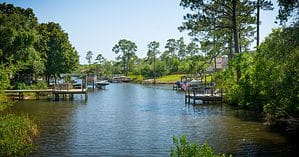There are a large number of trees native to New Jersey. Forest makes up forty percent of New Jersey. That is two million acres of trees! Many of these forest land areas are found in the northwestern and southeastern portions of the state. Oak and hickory forests are the most prevalent, with pine forests being a close second. Overall, New Jersey is home to hundreds of species of trees that provide countless benefits to local wildlife and the ecosystem as a whole.
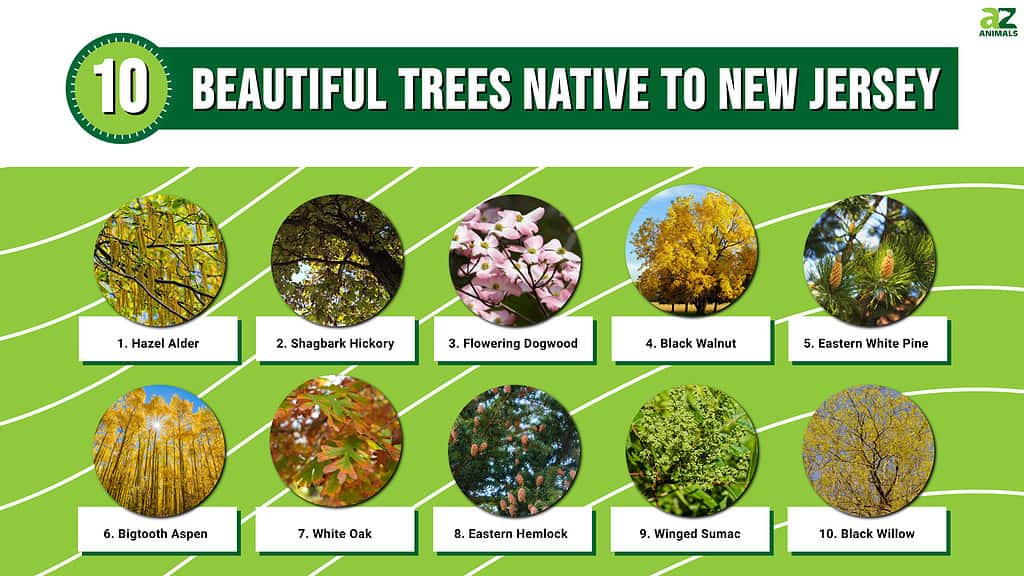
1. Hazel Alder
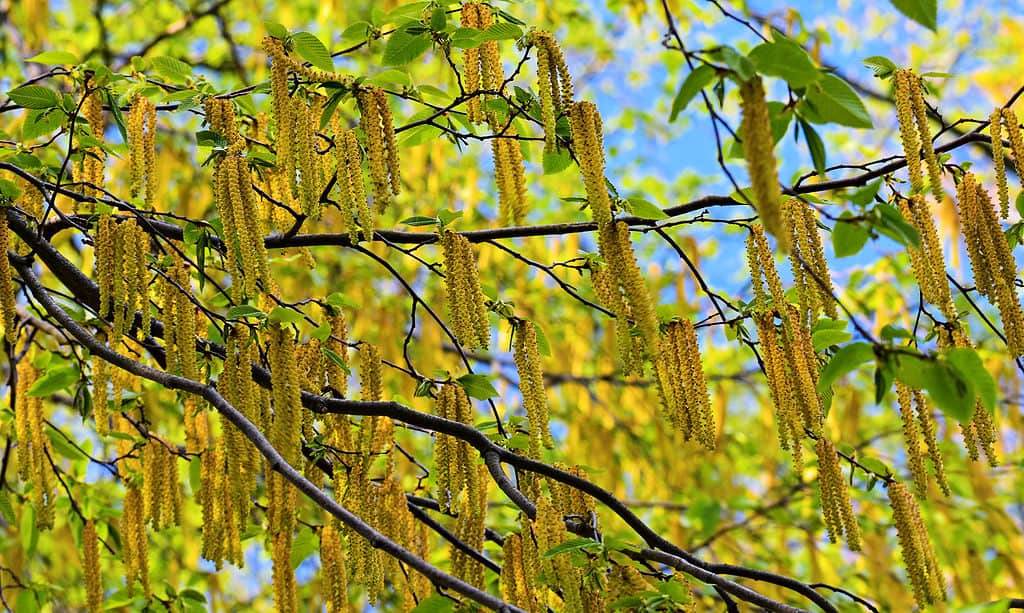
Hazel alders provide food and shelter for many species of local animals, birds, and insects.
©Gabriela Beres/Shutterstock.com
Hazel alder (Alnus serrulata) is also called smooth alder. It is a small tree or thicket-forming shrub native to New Jersey. It reaches 13 feet high and grows in moist soil near streams and ponds. The dark green leaves are two to four inches long.
Each year in March, it produces clusters of small reddish-green flowers followed by cone-like fruit. The fruits are filled with brown seeds that appear in fall and are favored by birds for their high-fat content. This tree provides food and shelter for many species of local animals, birds, and insects, making it an important part of the New Jersey ecosystem.
2. Shagbark Hickory
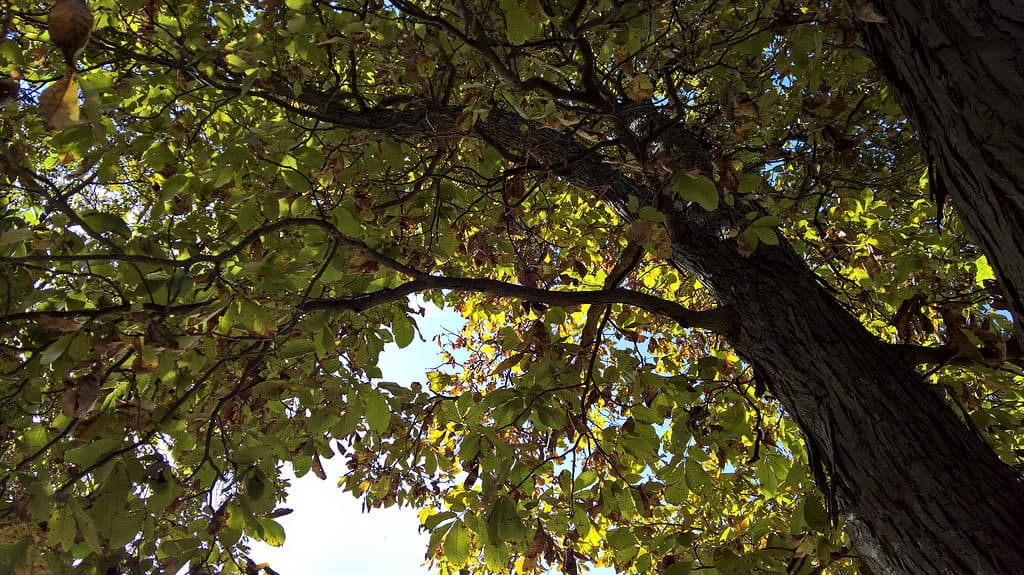
Shagbark hickory can grow over 100 feet tall and has distinctive bark that peels away in long, thick plates like shingles.
©iStock.com/Ethan R.
Shagbark hickory (Carya ovata) is a hickory tree native to New Jersey and other parts of the Eastern United States. It can grow over 100 feet tall and has distinctive bark that peels away in long, thick plates like shingles. The nut is light brown and has a very sweet taste.
The shagbark hickory provides important food sources for many local animals, including deer, squirrels, raccoons, chipmunks, and mice. You can also find black bears, foxes, and rabbits munching on hickory nuts. Other less common consumers include mallards, wood ducks, bobwhites, and wild turkeys.
3. Flowering Dogwood
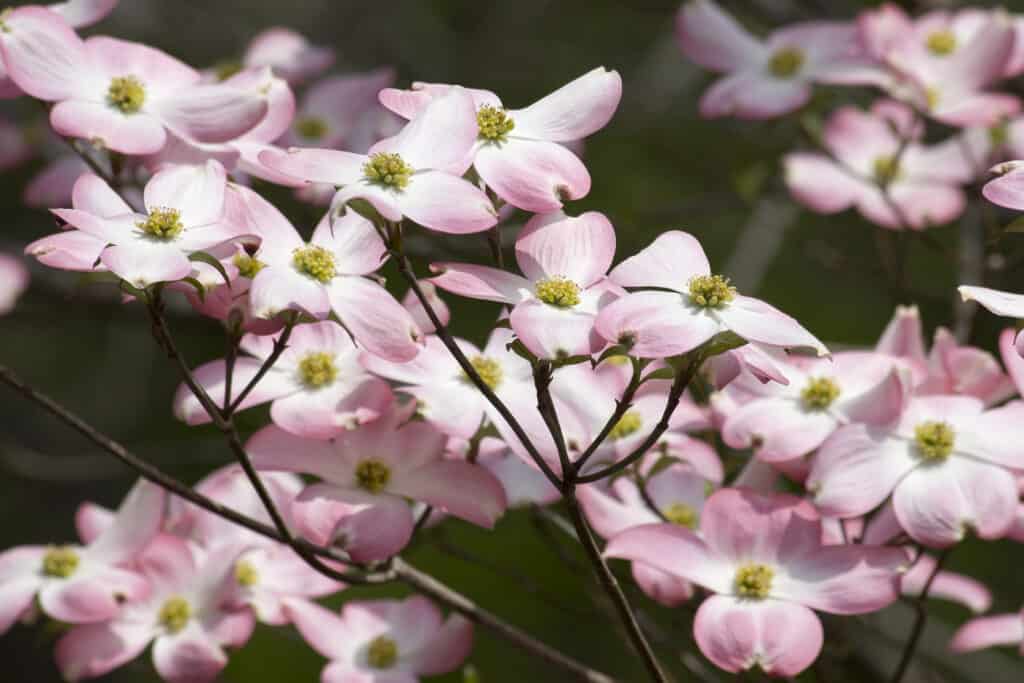
Flowering Dogwood grows to 33 feet tall and can be found growing wild at the edges of forests and on dry ridges.
©iStock.com/JillLang
Flowering dogwood (Cornus florida) is a deciduous tree native to parts of the eastern United States, including New Jersey. It grows to 33 feet tall and can be found growing wild at the edges of forests and on dry ridges.
It has beautiful white or pink blooms in late spring and early summer, followed by red-purple fruits that attract birds such as waxwings, robins, and cedar waxwings. The flowers provide nectar for bees and other beneficial insects, while the leaves supply food to caterpillars. In addition to being an attractive ornamental tree, flowering dogwood provides shelter and nesting sites for many bird species.
4. Black Walnut
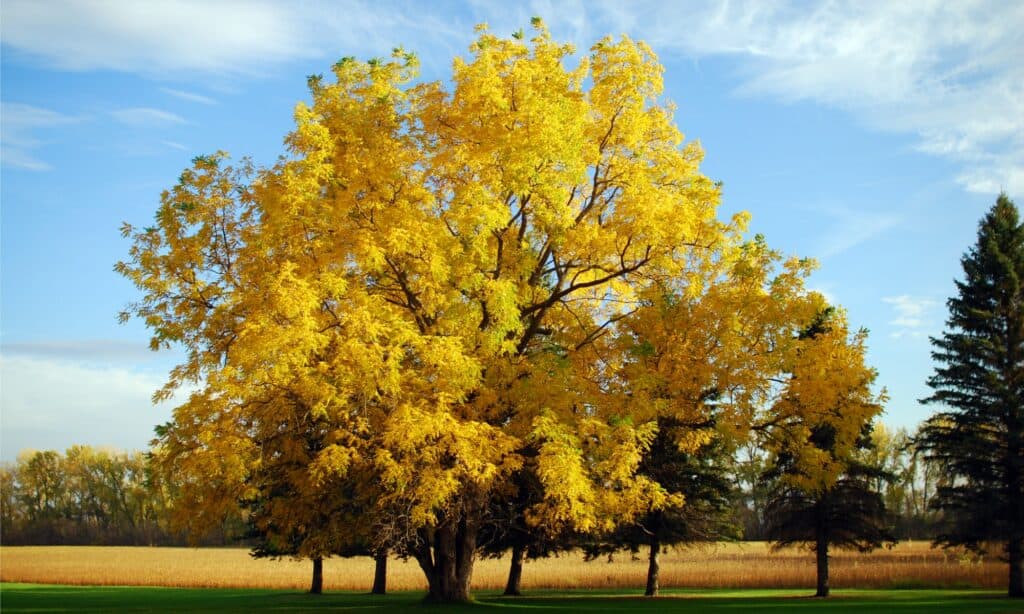
The wood from the black walnut is often used for furniture making due to its strength, stability, and beauty.
©iStock.com/jdt01fgo
The black walnut (Juglans nigra) is a deciduous tree native to New Jersey. It grows best in well-drained, moist soils and can reach heights of up to 130 feet tall with a trunk diameter of three feet or more. Its bark is grey-black with furrowed ridges in a diamond pattern.
Black walnut offers refuge to birds such as owls, hawks, and robins. It provides a food source for small mammals like squirrels in winter. Its nectar feeds bees, while its leaves are host plants for butterfly larvae like the tiger swallowtail butterfly. The wood from this tree is often used for furniture making due to its strength, stability, and beauty.
5. Eastern White Pine
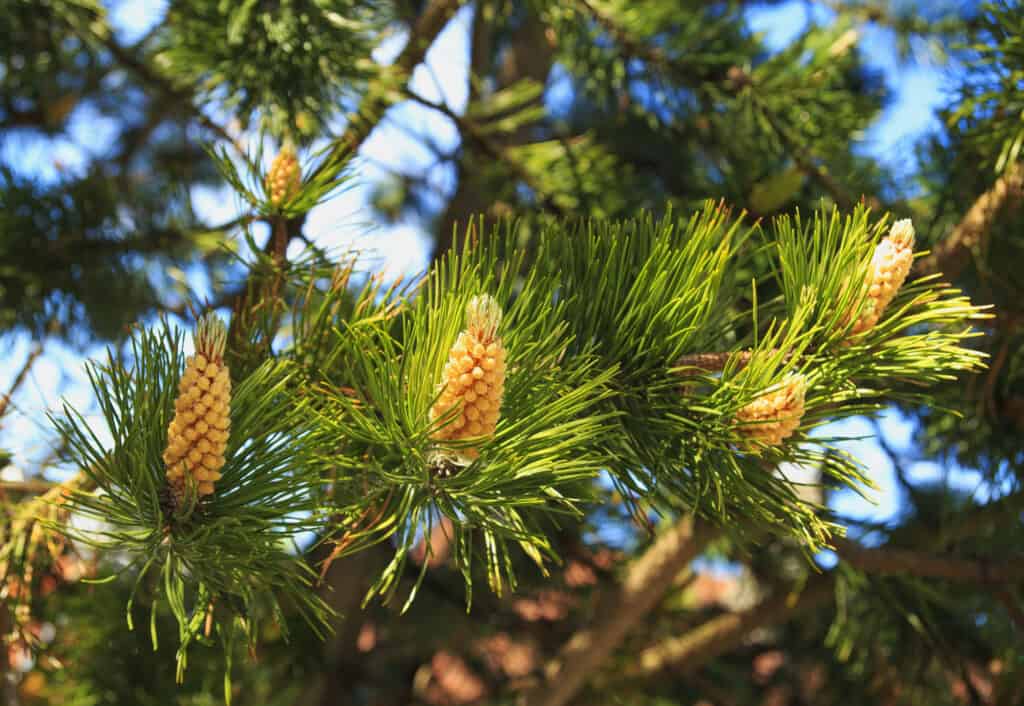
The eastern white pine is a favorite of red crossbills, as its large cones are full of seeds that they enjoy eating.
©Ukrolenochka/Shutterstock.com
Eastern white pine (Pinus strobus) is a large coniferous tree native to the Northeastern United States and parts of Canada. It has lovely blueish-green needles and slender seed cones full of seeds. This tree is often described as the tallest tree in New Jersey, reaching towering heights of 230 feet tall. It grows quickly, too, over three feet per year!
The eastern white pine is a favorite of red crossbills, as its large cones are full of seeds that they enjoy eating. In addition, squirrels often make nests in these trees, so they have a constant source of snacks right outside their front door.
6. Bigtooth Aspen
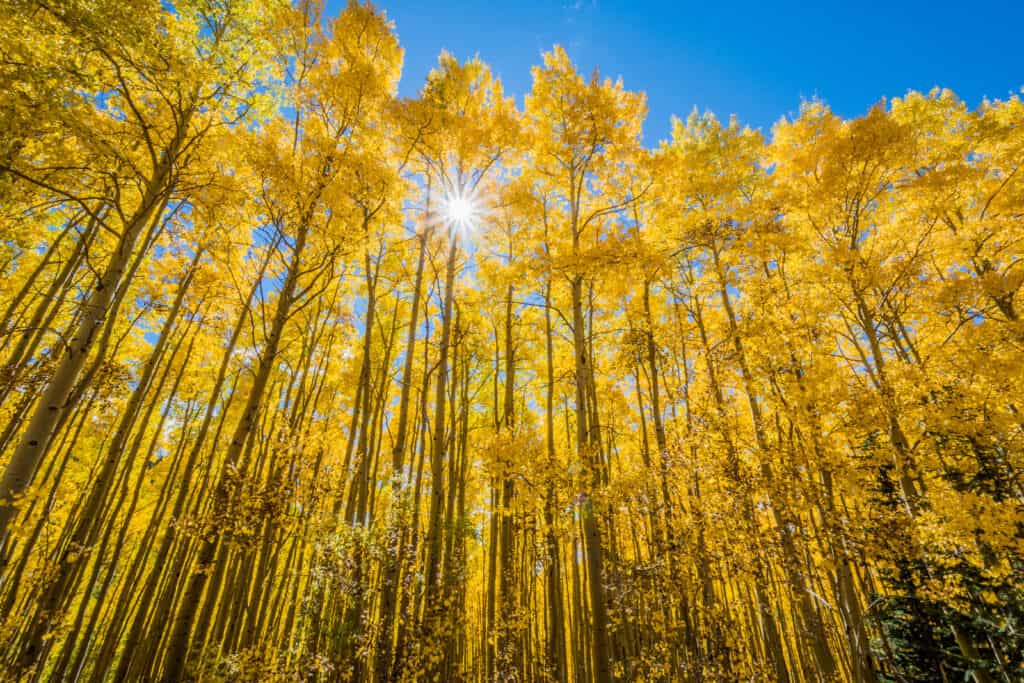
The bark of the bigtooth aspen is olive green and smooth when the tree is young, darkening, and getting rougher with age.
©iStock.com/Greg Meland
Bigtooth aspen (Populus grandidentata) is a deciduous tree growing throughout New Jersey. It is a medium-sized tree with small, oval leaves with large, toothed edges. The bark of this tree is olive green and smooth when the tree is young, darkening, and getting rougher with age.
This species produces flower clusters in the form of catkins full of seeds, which support many native animals, birds, and insects. The leaves are a favorite of both moose and white-tailed deer. Beavers dine on the bark, twigs, and branches. Ruffed grouse find bigtooth aspen leaves quite delicious. This tree is quite popular, with more than a hundred different birds using it as a breeding, roosting, and nesting site.
7. White Oak
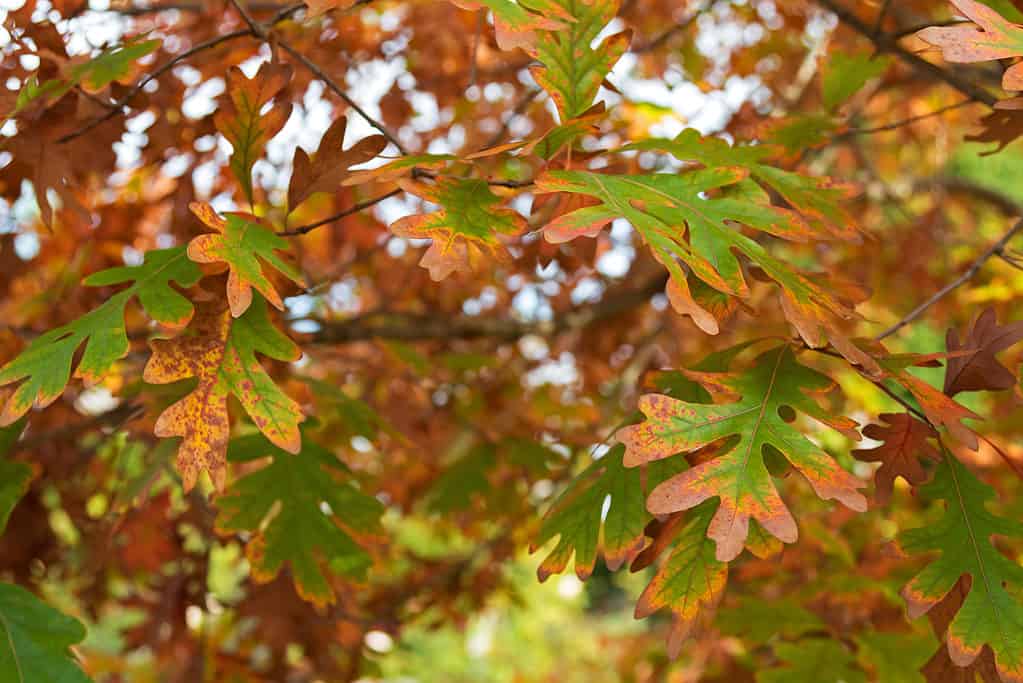
The bark of the white oak is thick and gray with shallow ridges along its length.
©sasimoto/Shutterstock.com
White oak (Quercus alba) is a tree species native to New Jersey and the surrounding states. It can grow 80-100 feet tall, with a wide spread of branches that make it an attractive ornamental landscape tree. White oak trees have deep green lobed leaves that turn yellow or brown in the fall season. The bark is thick and gray with shallow ridges along its length.
White oak produces acorns, a valuable food source for turkeys, wood ducks, pheasants, grackles, jays, nuthatches, thrushes, and woodpeckers. They are also a beloved snack for rabbits, squirrels, and deer. White oak is also a primary food source for two important caterpillars, the Bucculatrix luteella and Bucculatrix ochrisuffusa.
8. Eastern Hemlock
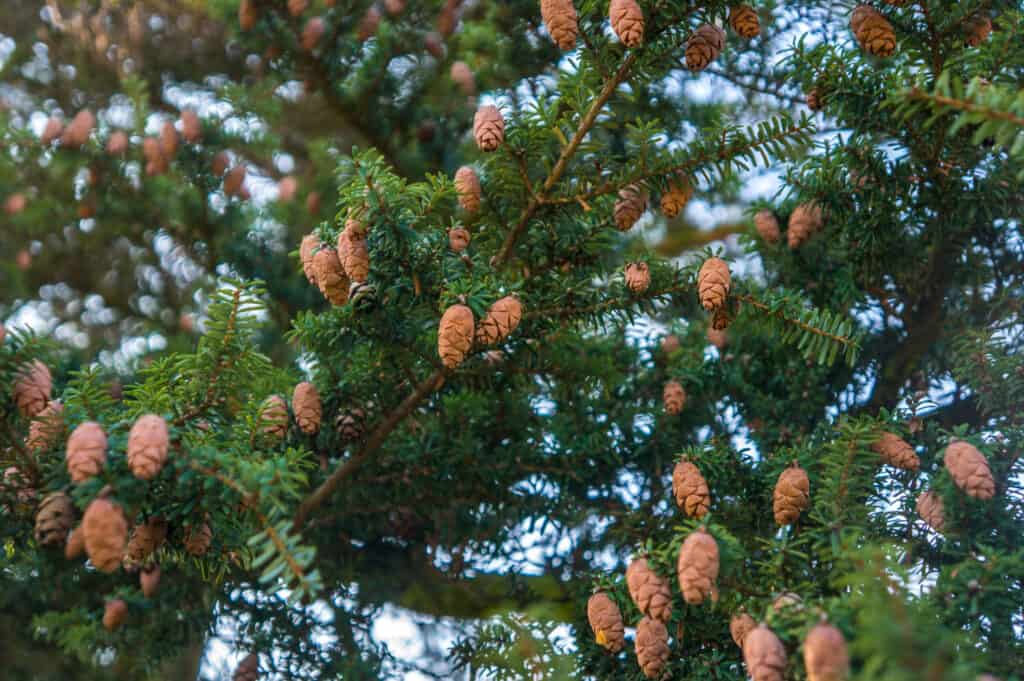
The cavity of large eastern hemlocks is a favorite den site for black bears, and mother bears often teach their cubs how to climb in this tree!
©iStock.com/Sara Lissaker
Eastern hemlock (Tsuga canadensis) is a coniferous evergreen tree native to eastern North America. It typically grows between 75 and 100 feet tall. Its bark is dark gray-brown, scaly, and deeply fissured with age. It produces oval seed cones that are around one inch long.
Eastern hemlock provides important shelter for many creatures, including black-throated and blackburnian warblers. The cavity of large eastern hemlocks is a favorite den site for black bears, and mother bears often teach their cubs how to climb in this tree! The seeds are a favorite snack for many birds and mammals. The foliage is food for white-tailed deer, snowshoe hares, and moose.
9. Winged Sumac
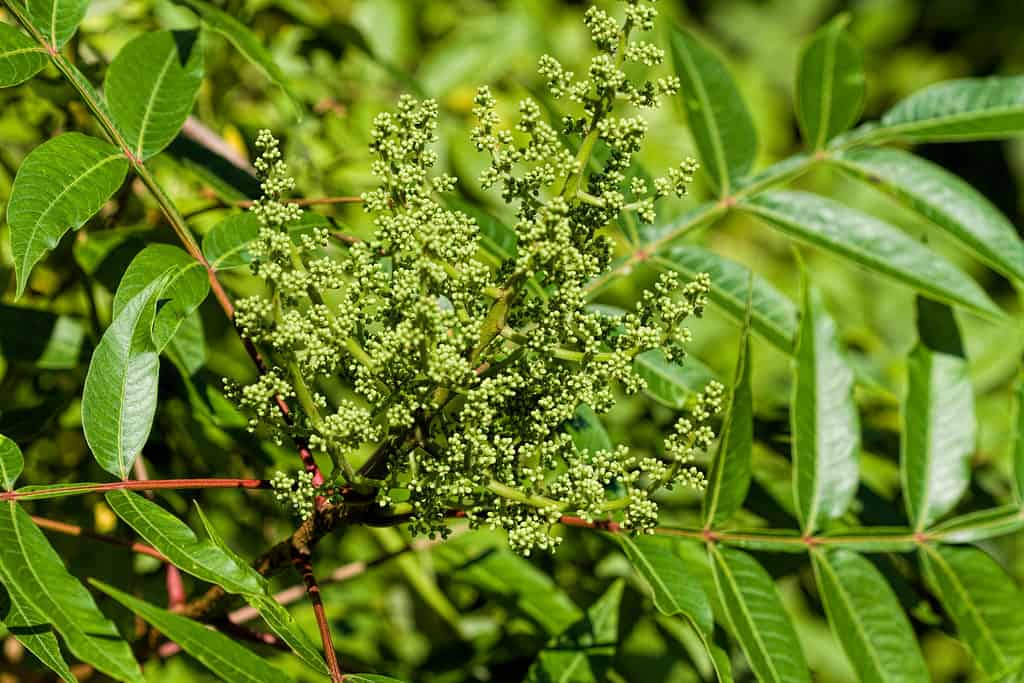
The tiny greenish-yellow flowers of the winged sumac are followed by red berries that feed wildlife throughout winter.
©Kathy Clark/Shutterstock.com
The winged sumac (Rhus copallinum) is a small tree native to New Jersey. It grows up to 20 feet in height and spreads by underground runners, forming a dense shrubby thicket. It is a prized ornamental plant because of its dark green foliage that turns bright orange and red in the fall. The tiny greenish-yellow flowers are followed by red berries that grow in clusters and feed wildlife throughout winter.
Winged sumac provides food for birds such as robins, waxwings, thrushes, woodpeckers, and others. Many mammals, including deer and squirrels, eat its fruit. It also serves as a host plant for several butterfly species, including the tiger swallowtail and eastern-tailed blue (Cupido comyntas) butterflies.
10. Black Willow
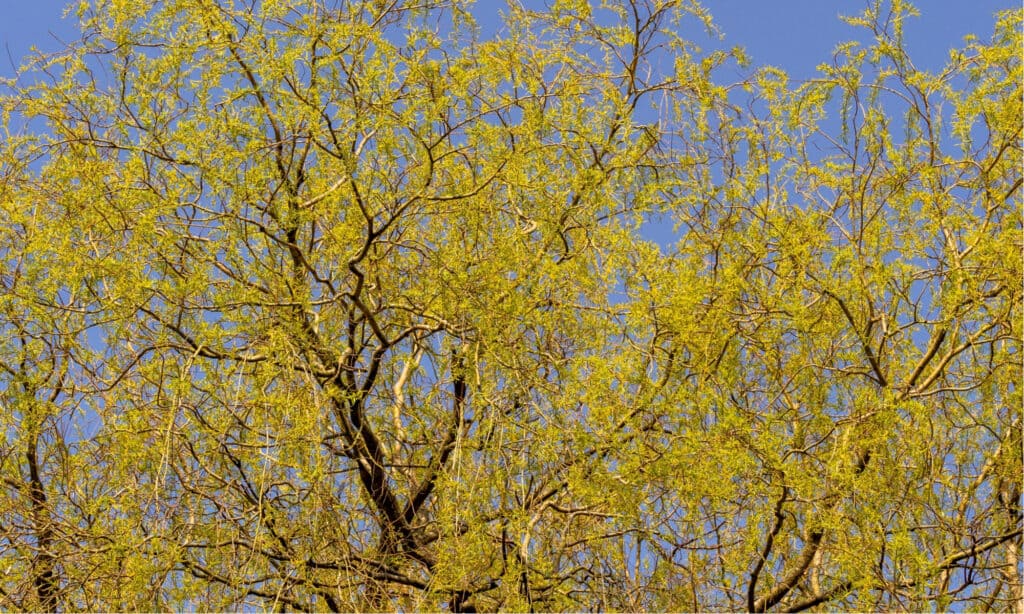
The black willow can grow to heights of up to 35-100 feet with a trunk diameter of up to 30 inches.
©Sue Burton Photography/Shutterstock.com
The black willow (Salix nigra) is a deciduous tree that grows throughout the state of New Jersey. It thrives in moist soils and often grows near ponds, lakes, rivers, and streams. This species can grow to heights of up to 35-100 feet with a trunk diameter of up to 30 inches. Its bark has an attractive dark brown hue with distinct fissures running along it.
This tree provides vital shelter and food sources for many animals, birds, and insects. It is also an important soil binder. Growing near banks of streams and rivers, the roots of this tree keep soil from eroding. This tree is one of the first to provide vital nectar and pollen to honey bees in the spring. Thickets of willow are favorite snacking territories for elk and beaver too.
Do Fruit Trees Grow in New Jersey?
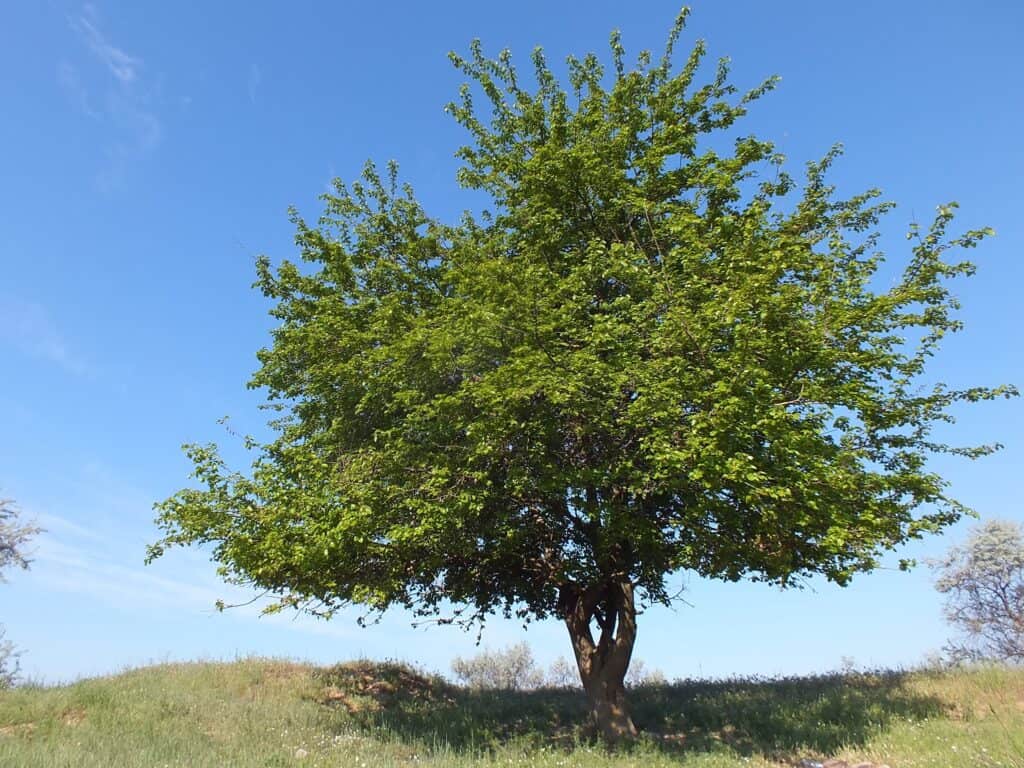
In addition to providing food for local wildlife, native fruit trees help support pollinator species like bees, essential for crop production.
©Roman Kutsekon/Shutterstock.com
New Jersey is home to a variety of native fruit trees and berries, including black cherry, highbush blueberry, pawpaw, wineberry, and mulberry. These trees and bushes are often found in woodlands or old homesteads throughout the state. In addition to providing food for local wildlife such as birds and mammals, these native fruit trees also help support pollinator species like bees which are essential for crop production.
Summary of 10 Trees Native to New Jersey
Here’s a recap of the 10 trees native to the state of New Jersey that we took a look at:
| Rank | Species | Maximum Height |
|---|---|---|
| 1 | Hazel Alder | 13 feet |
| 2 | Shagbark Hickory | 100 feet |
| 3 | Flowering Dogwood | 33 feet |
| 4 | Black Walnut | 130 feet |
| 5 | Eastern White Pine | 230 feet |
| 6 | Bigtooth Aspen | 80 feet |
| 7 | White Oak | 80-100 feet |
| 8 | Eastern Hemlock | 75-100 feet |
| 9 | Winged Sumac | 20 feet |
| 10 | Black Willow | 35-100 feet |
The photo featured at the top of this post is © sasimoto/Shutterstock.com
Sources
- New Jersey State, Available here: https://www.state.nj.us/pinelands/about/events/handouts/handouts/Pat%20Sutton/Pat%20Sutton's%20Native%20Tree-Shrub-Vine-LIST%20-%20NJ%20Pinelands.pdf
- New Jersey Native Plants, Available here: https://npsnj.org/native-plants/where-to-buy-natives/plant-lists/
- USDA, Available here: https://www.fs.usda.gov/database/feis/plants/tree/popgra/all.html#:~:text=IMPORTANCE%20TO%20LIVESTOCK%20AND%20WILDLIFE,over%20much%20of%20its%20range.
- USDA, Available here: https://www.fs.usda.gov/database/feis/plants/tree/tsucan/all.html#:~:text=Eastern%20hemlock%20has%20high%20cavity,hares%20%5B2%2C59%5D.
- USDA, Available here: https://plants.usda.gov/DocumentLibrary/factsheet/pdf/fs_sani.pdf
- USDA, Available here: https://www.fs.usda.gov/nrs/pubs/ru/ru_fs167.pdf
Thank you for reading! Have some feedback for us? Contact the AZ Animals editorial team.






